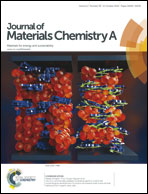Core–shell Co@C catalyzed MgH2: enhanced dehydrogenation properties and its catalytic mechanism†
Abstract
An efficient core–shell Co@C catalyst is synthesized through a solvothermal and subsequent annealing process. The as-synthesized Co@C consists of an 11 nm Co core and a 3 nm amorphous carbon shell. Nitrogen sorption isothermals show that Co@C has a surface area of 112.6 m2 g−1 and a typical pore size of 4.8 nm. The catalytic effects of core–shell Co@C, which can significantly improve the dehydrogenation performance of MgH2, are systematically investigated. With increasing amounts of Co@C (0, 3, 5, 10, 15 wt%), the dehydrogenation temperature of MgH2 decreased. Its dehydrogenation kinetics are also improved, especially for the MgH2–10%Co@C sample, which starts to release hydrogen at 168 °C. In fact, about 6.00 wt% hydrogen is released during its decomposition, and the activation energy of MgH2–10%Co@C is determined to be 84.5 kJ mol−1, 46.2% less than that of pure MgH2. Mechanism analysis indicates that upon increasing the Co@C content, the decomposition of MgH2 gradually occurs along lower-dimensional nucleation and growth. Moreover, the excellent thermal conductivity of the carbon shell in Co@C also contributes to the enhanced dehydrogenation performance of MgH2.


 Please wait while we load your content...
Please wait while we load your content...